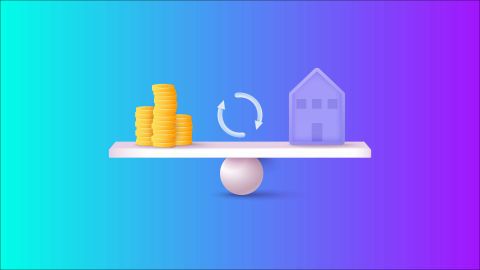The Income Tax Act, 1961, provides rules for how an individual’s income is taxed. It gives rules for tax calculation, deductions, exemptions, penalties, and procedures for taxpayers.
An important deduction every salaried taxpayer and pensioner must know is the “standard deduction”. This deduction does not require the taxpayer to show any bills, investments, or expenses.
The standard deduction was brought back in the Union Budget of 2018, under Section 16(ia) of the Income Tax Act. It replaced two earlier deductions:
- One for transport allowance
and
- Another for medical reimbursement
Instead of claiming both separately, taxpayers can now claim a fixed deduction.
As per the current rule, the standard deduction is Rs. 50,000 (under the old regime) and Rs. 75,000 (under the new regime).
By using this deduction, you can directly reduce the taxable salary income and lower your tax liability. Want to know more? This article explains the concept of standard deduction, including its eligibility criteria and method of calculation.
Also, you will learn about the applicable limits and certain key documents needed to claim this deduction.
What is Section 16 of the Income Tax Act?
Section 16 of the Income Tax Act, 1961, deals with the deductions allowed to salaried individuals in computing their taxable income. It outlines various allowances and deductions that can be claimed by employees to reduce their taxable salary income. These deductions aim to provide relief to taxpayers and encourage savings and investments. Additionally, Section 16 specifies the standard deduction available to employees under subsection (ia), which provides a flat deduction from their gross salary income, irrespective of their actual expenses.
What is standard deduction?
Standard deduction is a fixed amount that salaried individuals and pensioners can subtract from their total salary income before calculating their income tax. This reduces their taxable income and lowers the tax they have to pay. It does not require:
- Any bills
or
- Proof of expenses
It is given automatically if you are eligible. Earlier, the standard deduction was Rs. 50,000 for salaried employees and Rs. 15,000 for family pensioners. In Budget 2024, the government increased this amount to Rs. 75,000 for salaried individuals, but only under the new tax regime.
Under the old tax regime, the limit remains Rs. 50,000. For family pensioners, the deduction was increased from Rs. 15,000 to Rs. 25,000.
In Budget 2025, the income tax exemption limit under the new tax regime was raised to Rs. 12 lakh per year. With the Rs. 75,000 standard deduction added, individuals earning up to Rs. 12.75 lakh annually under this regime will not have to pay income tax.
Please note that this deduction is available to all salaried individuals and pensioners (regardless of their personal expenses or savings).
Standard deduction for FY 2024-25 under the new tax regime
For the FY 2024–25 (AY 2025–26), there is an important change related to the standard deduction under the new tax regime.
The government has increased the standard deduction from Rs. 50,000 to Rs. 75,000 for those choosing the new regime (also the default option). Employers will now show this higher deduction in Form 16 while calculating TDS on salary. For those unaware, Form 16 is a document issued by employers. It shows details of:
● An employee’s salary
and
● The tax deducted at source (TDS) during a financial year
Please note that if an individual initially selects the new tax regime but later switches to the old tax regime at the time of filing their ITR, then the standard deduction will be reduced to Rs. 50,000 (as the old regime still allows only that amount).
Standard deductions under Section 16(ia)
Under Section 16(ia) of the Income Tax Act, salaried individuals are eligible for standard deductions from their salary income. These standard deductions aim to provide relief to taxpayers by reducing their taxable income. Here are the details of the standard deductions under Section 16(ia):
- Transport allowance: Prior to the introduction of the standard deduction, employees were eligible to claim a transport allowance as part of their salary package. This allowance was meant to cover commuting expenses incurred by employees for travelling to and from their workplace. However, with the implementation of the standard deduction, the transport allowance component has been subsumed into the standard deduction.
- Medical reimbursement: Similarly, employees were entitled to claim medical reimbursement as part of their salary package to cover medical expenses for themselves and their dependants. However, with the introduction of the standard deduction, the medical reimbursement component has also been subsumed into the standard deduction.
- Standard deduction: As per the Finance Act, 2018, a standard deduction of Rs. 40,000 has been introduced for salaried individuals under Section 16(ia). This standard deduction is applicable to all eligible taxpayers, irrespective of their actual expenses on transport or medical reimbursements. It serves as a flat deduction from the gross salary income of the taxpayer, thereby reducing their taxable income.
It is important to note that the standard deduction under Section 16(ia) replaces the earlier components of transport allowance and medical reimbursement. Taxpayers are not required to provide any proof or documentation of actual expenses incurred on transport or medical reimbursements to claim this standard deduction. However, individuals opting for the new tax regime introduced in the Finance Act, 2020, are not eligible for this standard deduction.
Purpose of standard deduction
The standard deduction was reintroduced in the Union Budget 2018 as an exclusive benefit to salaried individuals and pensioners. Let’s check out some of its main purposes:
- It reduces paperwork. Unlike other tax deductions that require proof of expenses, the standard deduction is given as a fixed amount. There is no need to show any documents. This makes it easier to file ITRs.
- It provides tax relief to middle-class salary earners. Since they form a large part of the working population, this fixed deduction:
- Reduces their taxable income
and
- Lowers their tax burden
Additionally, the deduction also applies to pensioners. It gives them some financial relief after retirement. Earlier, pensioners had limited tax benefits. But now, with the standard deduction, they too can reduce their taxable pension income without meeting any specific conditions.
Standard deduction for senior citizens
As per the Income Tax Act, 1961, any person between the ages of 60 and 80 is considered a senior citizen in India. Many senior citizens receive a pension after retirement. This pension is considered part of the "salary" income category, and therefore, it is taxable.
Now, to reduce the tax burden on pensioners, the government provides a benefit under Section 16(ia) of the Income Tax Act. This section allows a standard deduction for pension income, just like it is allowed for salaried employees.
From FY 2024-25 onwards, the amount of deduction available is the lower of the following:
- Rs. 50,000 (old regime)/ Rs. 75,000 (new regime)
or
- The actual amount of pension received in a year
As a pensioner, you can subtract this deduction from your total pension income.
This benefit lowers your taxable income without having to provide any documents or proof.
Earlier, pensioners had to rely on other limited deductions. But after the reintroduction of standard deduction (in the Union Budget 2018), pensioners now get a fixed tax relief each year.
Please note that the purpose of this deduction is to provide some financial support to senior citizens. It has been recognised that they may have:
- Limited income
and
- Higher medical or living expenses
Thus, this standard deduction lowers the amount of income on which tax is paid and improves the financial stability of pensioners.
When planning your retirement finances or considering home ownership as a senior citizen, understanding all available tax benefits becomes crucial. Bajaj Finserv Home Loan offers competitive interest rates starting at 7.45%* p.a with flexible repayment options up to 32 years. Check your eligibility for a home loan from Bajaj Finserv today. You may already be eligible, find out by entering your mobile number and OTP.
How does standard deduction reduce taxable income?
The standard deduction is a flat or fixed subtraction from the income of salaried individuals and pensioners. It reduces the total taxable income, which lowers the amount of tax they need to pay.
Under the old tax regime, the standard deduction is Rs. 50,000. Whereas, under the new tax regime, it is Rs. 75,000. This deduction is allowed to everyone who earns a salary or pension (regardless of how much they earn).
The deduction is meant to cover general expenses that are not covered under other specific sections of the tax law. For more clarity, let’s study an example:
- Say a person earns Rs. 12,00,000 a year.
- They chose the new tax regime.
- So, Rs. 75,000 will be deducted from that amount.
- Their taxable income becomes Rs. 11,25,000
Now, the income tax will be calculated on this reduced amount.






